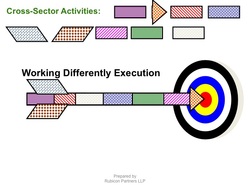
Our work with multiple communities across North America has given us insight to the four steps required to assure community sanity in the midst of achieving sustainable outcomes. Assuring execution across these four steps is the foundational requirement for any successful multi-partner endeavor. It is all the more important when these partners are across sectors. In that case, this is the core of what a community support organization, roundtable and/or backbone organization must deliver.
First, clarity on the target (see figure). Where communities fail to to even get out of the gate to meaningful change is their failure to agree on a shared definition of what is the target of our collective efforts and how will we know if we are making progress to that result. For many, there is a reluctance to make this goal concrete for fear of disengaging some partner or because it involves the tough work of getting beyond jargon and assumptions. As I discuss in other blog postings (most particularly in the recent Understanding Measures), the reluctance to be crystal clear on the target quickly metastasizes into on-going debating societies among good people where much time is used but very little meaningful progress is charted.
Second, embrace the fact that activities beyond those being done by "the usual suspects" are vital to success. (In a future blog posting, I'll discuss how the most significant player in a community achieving kindergarten readiness was the town's largest employer.) To truly engage the entire community in this effort requires the humility to understand that it involves so much more than mapping current activities (see figure). We must begin with a comfort about "what we don't know." An important test here is assessing the level of community engagement in the partnership -- if the vast majority of those organizations involved are in some way funded to be there, then you are not reaching far enough.
Third, create a means for all parts of the community to align to your efforts. This is the core of execution in that collective space above the "command and control" structures of individual organizations and institutions. Execution here moves from dictate to enable. No community collective has (or should have) the power to force action, but they certainly have the ability to help organizations and individuals ask and answer the simple question: "what can I do?" This aligning arrow (see figure) that you are creating is made possible by a whole series of resources from shared language, to shared measures, to supporting data and indicators to published checklists to communications to best practice case studies to training. This step is particularly helpful when thinking about funding decisions: there should be less emphasis for this effort to fund activities (those have better sources of funds and tends to disengage non-funded, but vital community activities) rather here the need is to fund those things that allow disparate organizations to align, coordinate and manage to the shared outcome: e.g., universal assessments; common data systems, etc.
And, fourth, recognize and salute the many community activities that have aligned on your arrow. This will serve to model and induce broader community engagement to propel the outcome forward. Communities have done this in annual gatherings, newspaper articles and tweets. The key gravitational pull is the ongoing reporting on the progress to the shared target. This brings us back to the importance of the first step to continually improving your execution.
To be tweeted links to my new posts -- blog, book reviews (both nonfiction and fiction), data or other recommended tools -- either go to Twitter.com and follow me @jcrubicon, or just go to my Home page and click on the Twitter button on the right, just above the tweet stream, and follow me @jcrubicon.
 RSS Feed
RSS Feed
